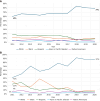Influence of substance use on rising hepatitis A hospitalizations in the United States: A decade-long comparative study
- PMID: 40575642
- PMCID: PMC12188861
- DOI: 10.5501/wjv.v14.i2.97421
Influence of substance use on rising hepatitis A hospitalizations in the United States: A decade-long comparative study
Abstract
Background: Hepatitis A virus (HAV) infection remains the most common cause of acute viral hepatitis globally. In the United States, recent outbreaks have been attributed primarily to person-to-person transmission, with vulnerable populations such as people who use illicit drugs, those experiencing homelessness, and men who have sex with men disproportionately affected.
Aim: To assess the trends in HAV hospitalizations over the past decade and evaluate the impact of substance use on these hospitalizations.
Methods: We conducted a retrospective study using the National Inpatient Sample database from 2011 to 2020. Adults (≥ 18 years) hospitalized with a primary diagnosis of HAV infection were included. We identified active substance use as a secondary diagnosis. Statistical analysis involved descriptive statistics, trend analysis, and propensity score matching to compare HAV hospitalizations with and without substance use. Outcomes included hospitalization trends, complications, length of stay (LOS), and mortality.
Results: From 2011 to 2020, there were 56972 hospitalizations for HAV infections. Hospitalizations increased from 3917 in 2011 to 8290 in 2020, peaking at 9800 in 2018. Caucasian males (55%) were the most affected, with a mean age of 49 years. The prevalence of active substance use among HAV hospitalizations was 27%, with these patients being younger (mean age: 39 years) and predominantly male (63.1%). HAV hospitalizations associated with substance use increased significantly, rising from 235 cases in 2011 to 3200 in 2020 (P < 0.001). Compared to HAV hospitalizations without substance use, those with substance use had higher rates of co-infections (hepatitis C virus 45% vs 11%, hepatitis B virus 11% vs 6%) and complications, including sepsis (1.9% vs 1%) and infective endocarditis (1.4% vs 0.15%, P < 0.001). Hospitalizations with substance use also had longer LOS (4.34 days vs 3.97 days, P < 0.05), but mortality rates were comparable. Predictors of mortality in HAV-substance use hospitalizations included acute liver failure, sepsis, and acute respiratory failure.
Conclusion: HAV hospitalizations in the United States have significantly increased over the past decade, with the rise driven by cases involving substance use. These patients face a higher burden of complications and healthcare utilization. Tailored public health strategies, including targeted vaccination and outreach programs for at-risk populations, are essential to reduce the morbidity, mortality, and economic burden associated with HAV.
Keywords: Bacterial; Endocarditis; Hepatitis A; Hepatitis A virus; Hospitalization; Public health; Sepsis; Substance-related disorders; Vaccination.
©The Author(s) 2025. Published by Baishideng Publishing Group Inc. All rights reserved.
Conflict of interest statement
Conflict-of-interest statement: The authors declare no conflicts of interest.
Figures


Similar articles
-
Behavioral interventions to reduce risk for sexual transmission of HIV among men who have sex with men.Cochrane Database Syst Rev. 2008 Jul 16;(3):CD001230. doi: 10.1002/14651858.CD001230.pub2. Cochrane Database Syst Rev. 2008. PMID: 18646068
-
NIH Consensus Statement on Management of Hepatitis C: 2002.NIH Consens State Sci Statements. 2002 Jun 10-12;19(3):1-46. NIH Consens State Sci Statements. 2002. PMID: 14768714
-
Population-based interventions for reducing sexually transmitted infections, including HIV infection.Cochrane Database Syst Rev. 2004;(2):CD001220. doi: 10.1002/14651858.CD001220.pub2. Cochrane Database Syst Rev. 2004. Update in: Cochrane Database Syst Rev. 2011 Mar 16;(3):CD001220. doi: 10.1002/14651858.CD001220.pub3. PMID: 15106156 Updated.
-
Surveillance for Violent Deaths - National Violent Death Reporting System, 50 States, the District of Columbia, and Puerto Rico, 2022.MMWR Surveill Summ. 2025 Jun 12;74(5):1-42. doi: 10.15585/mmwr.ss7405a1. MMWR Surveill Summ. 2025. PMID: 40493548 Free PMC article.
-
Does Augmenting Irradiated Autografts With Free Vascularized Fibula Graft in Patients With Bone Loss From a Malignant Tumor Achieve Union, Function, and Complication Rate Comparably to Patients Without Bone Loss and Augmentation When Reconstructing Intercalary Resections in the Lower Extremity?Clin Orthop Relat Res. 2025 Jun 26. doi: 10.1097/CORR.0000000000003599. Online ahead of print. Clin Orthop Relat Res. 2025. PMID: 40569278
References
-
- Nelson NP, Weng MK, Hofmeister MG, Moore KL, Doshani M, Kamili S, Koneru A, Haber P, Hagan L, Romero JR, Schillie S, Harris AM. Prevention of Hepatitis A Virus Infection in the United States: Recommendations of the Advisory Committee on Immunization Practices, 2020. MMWR Recomm Rep. 2020;69:1–38. - PMC - PubMed
LinkOut - more resources
Full Text Sources
Miscellaneous

